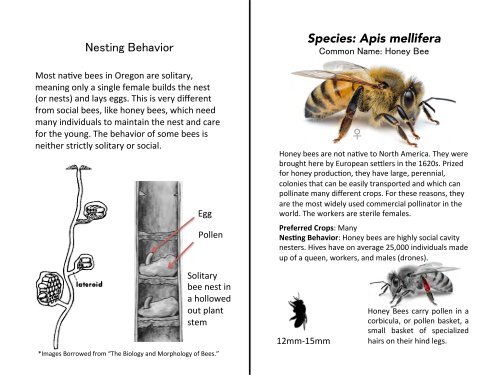You also want an ePaper? Increase the reach of your titles
YUMPU automatically turns print PDFs into web optimized ePapers that Google loves.
tus<br />
Nesting Behavior <br />
Most naFve bees in Oregon are solitary, <br />
meaning only a single female builds the nest <br />
(or nests) and lays eggs. This is very different <br />
from 243 social bees, like honey bees, which need <br />
many Paroxystoglossa<br />
individuals maintain the nest and care <br />
for the jocasta young. The behavior of some bees is <br />
neither strictly solitary or social. <br />
263<br />
lateroid<br />
Halictus farinosus<br />
245<br />
. (Lasioglossum) duplex<br />
Egg <br />
Pollen <br />
Solitary <br />
bee nest in <br />
a hollowed <br />
out plant <br />
stem <br />
*Images Borrowed from “The Biology and Morphology of Bees.” <br />
264<br />
Osmia lignaria<br />
265<br />
Apis mellifera<br />
Species: Apis mellifera<br />
Common Name: Honey Bee <br />
♀ <br />
Honey bees are not naFve to North America. They were <br />
brought here by European seWlers in the 1620s. Prized <br />
for honey producFon, they have large, perennial, <br />
colonies that can be easily transported and which can <br />
pollinate many different crops. For these reasons, they <br />
are the most widely used commercial pollinator in the <br />
world. The workers are sterile females. <br />
Preferred Crops: Many <br />
Nes,ng Behavior: Honey bees are highly social cavity <br />
nesters. Hives have on average 25,000 individuals made <br />
up of a queen, workers, and males (drones). <br />
12mm-‐15mm <br />
Honey Bees carry pollen in a <br />
corbicula, or pollen basket, a <br />
small basket of specialized <br />
hairs on their hind legs.


